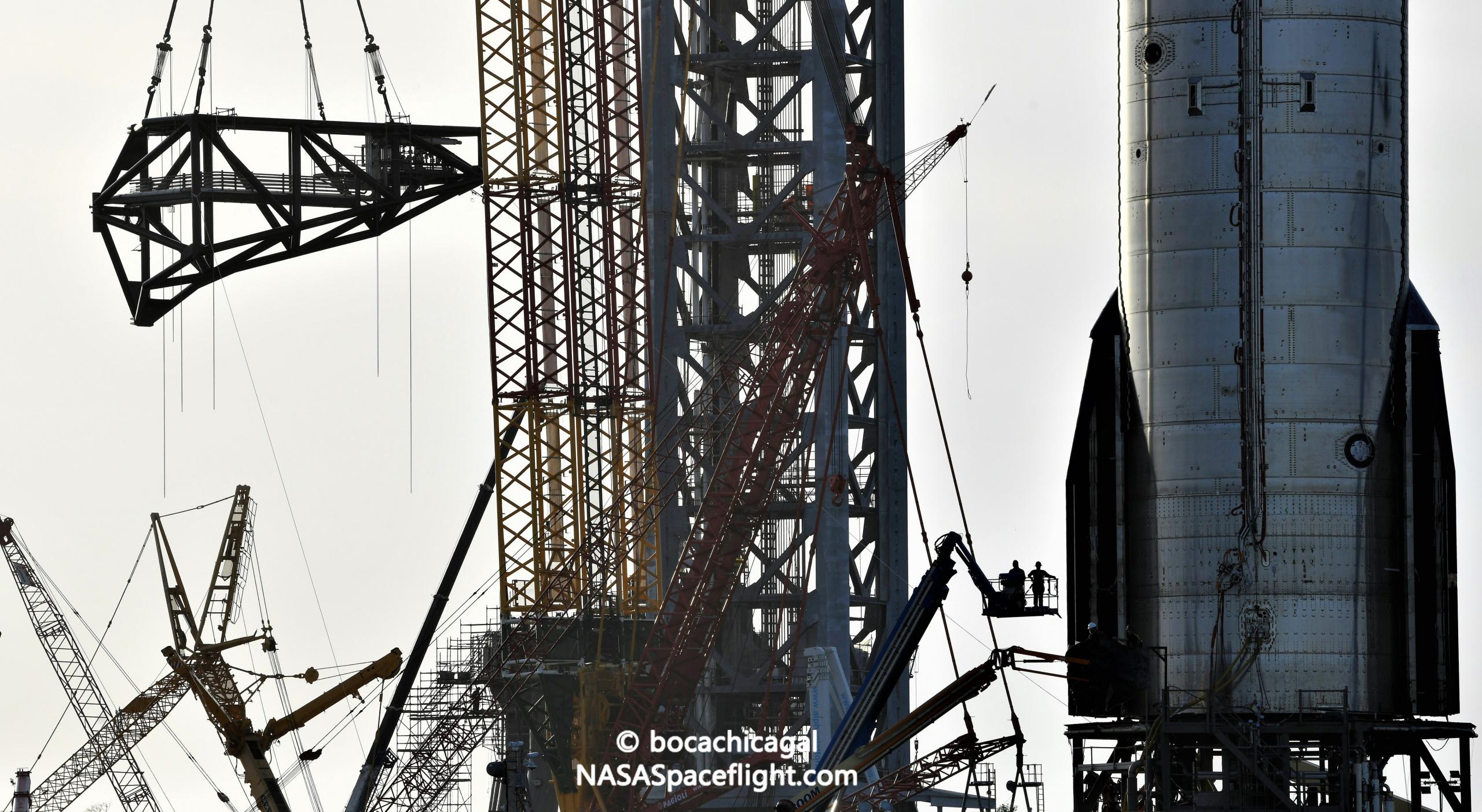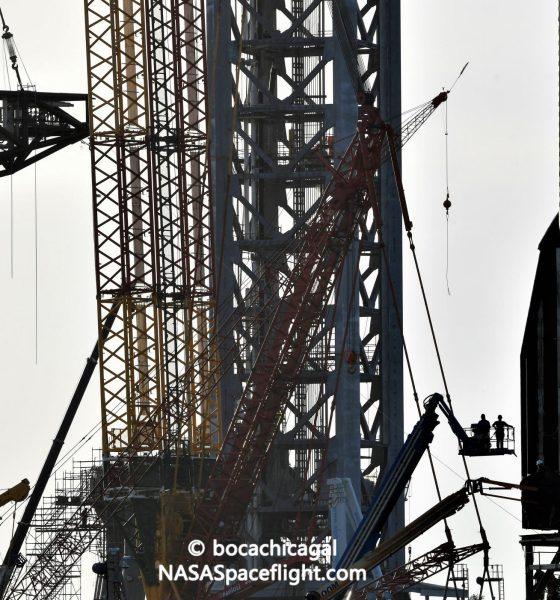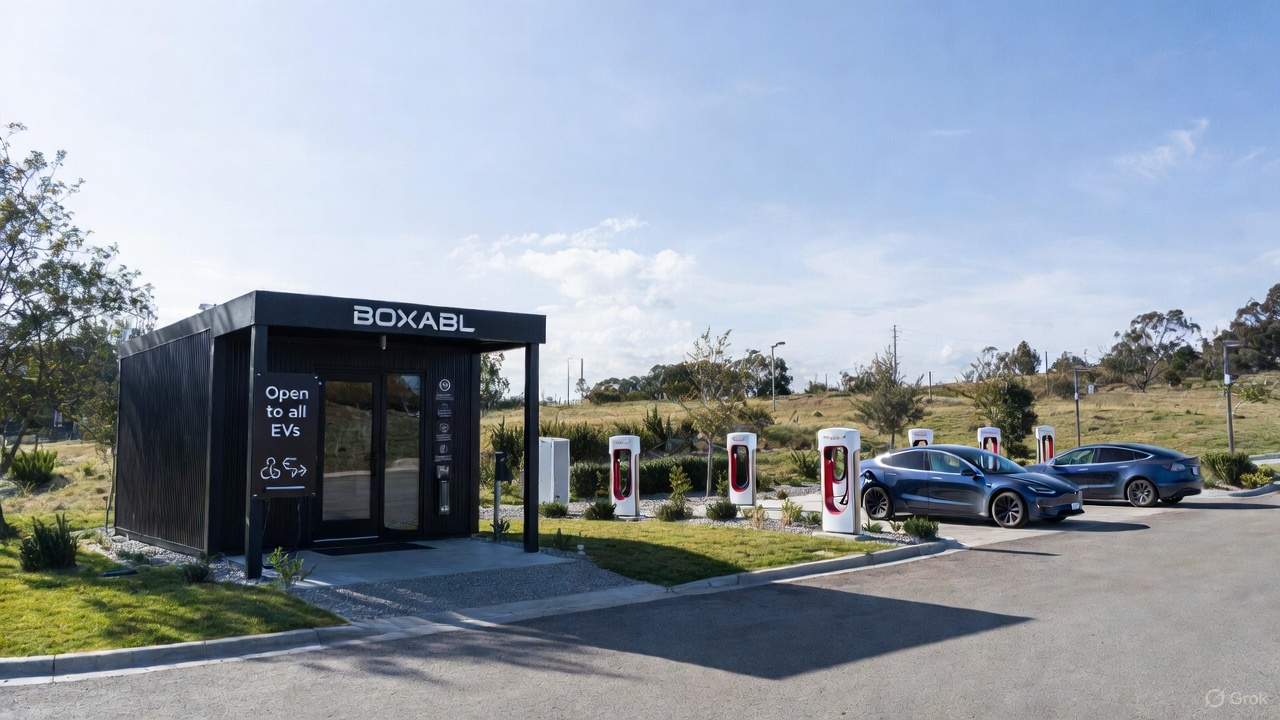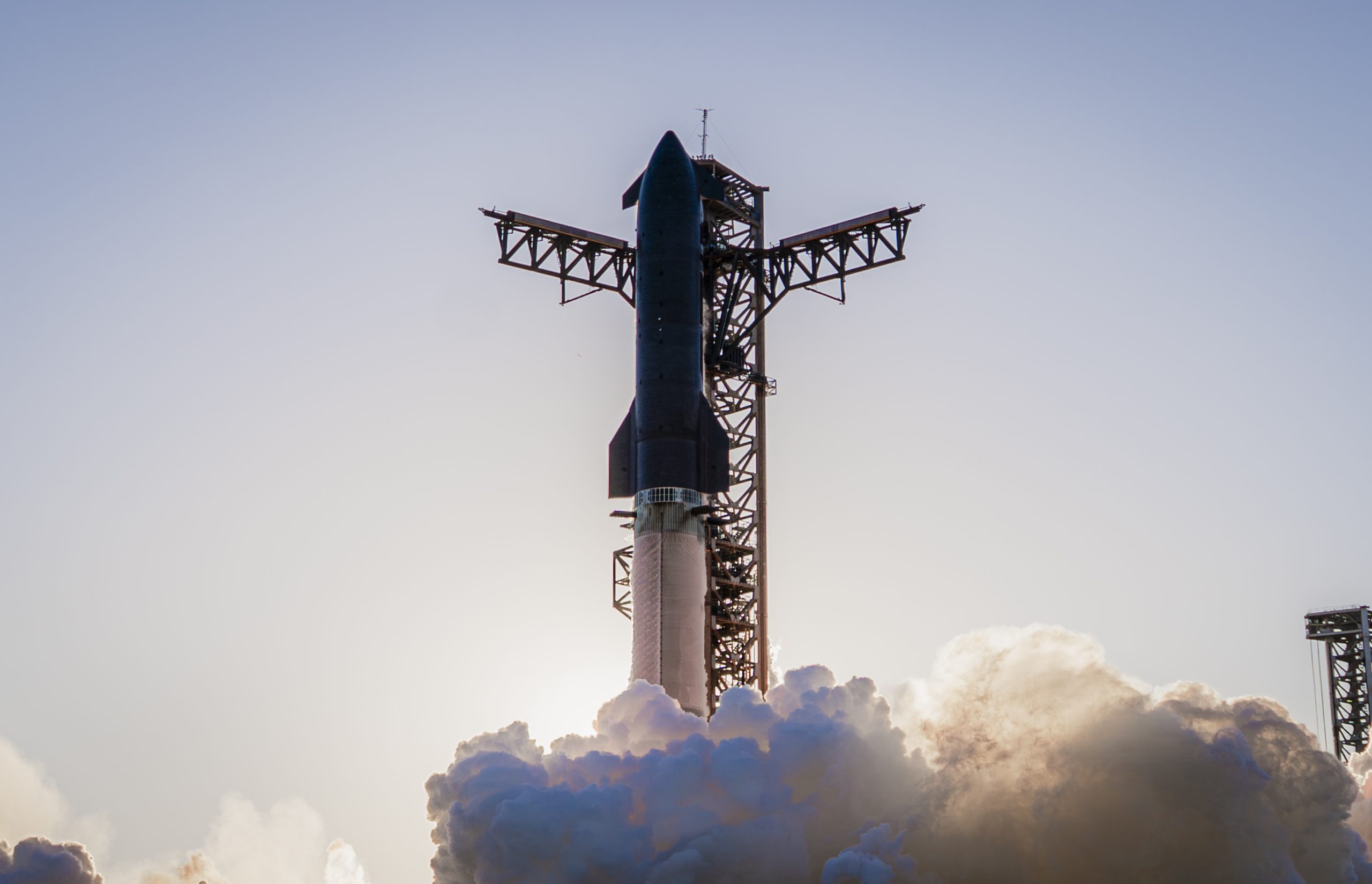

News
SpaceX installs first ‘Mechazilla’ arm on Starship launch tower
One month after SpaceX stacked Starship’s South Texas ‘launch tower’ to its full height, the company has installed the first arm on what amounts to the backbone of ‘Mechazilla.’
At the end of July, after less than four months of work, a team of SpaceX workers and contractors installed the final prefabricated section of a ~145m (~475 ft) tall tower meant to support orbital Starship launches. Above all else, SpaceX’s first custom-built ‘launch tower’ is a sort of backbone or anchor point for several massive, mechanical arms that will accomplish the actual tasks of servicing – and, perhaps, catching – Starships and Super Heavy boosters.
Work on all three of the arms expected to make up what SpaceX CEO Elon Musk has described as “Mechazilla” has been visibly underway since the last week of June as a small army of welders carefully assembled dozens of sections of heavy-duty steel pipe into house-sized frames. Almost exactly two months later, SpaceX has installed the first of those three arms on the exterior of Starship’s skyscraper-sized launch tower.
Known as the tower’s quick-disconnect or QD swing arm, the standalone structure is reportedly designed to accomplish a few different tasks. First, as its unofficial name might suggest, the QD arm will hold a quick-disconnect umbilical connector that will temporarily attach to the base of Starships to load them with fuel, oxidizer, and other consumables and link them to ground power and networking. For years, it appeared that SpaceX planned to fuel Starship upper stages through their Super Heavy boosters, which will themselves be connected to umbilical panels on a table-like launch mount that sits beside the tower.
However, once work began on Starship S20, the first potentially space-capable prototype, it was clear that SpaceX had foregone the umbilical plate normally installed at the base of Starship skirts and moved that connection to the ship’s lower back. Musk later confirmed as much in interviews and tweets, revealing that longstanding plans to dock Starships aft to aft for in-space refueling were also up in the air. As of late, aside from reiterating that the launch pad itself (“Stage Zero,” per Musk) is even more complex and difficult than Starship or Super Heavy, SpaceX’s CEO has also repeatedly stated a desire to offload as many systems as possible onto the launch pad – seemingly regardless of the complexity of the alternative.

Enter the building-sized robot informally known as Mechazilla. While the relatively simple swinging ‘QD arm’ that will fuel Starship and stabilize both stages of the rocket is a common feature of rockets and launch pads, the only experience SpaceX itself has with umbilical swing arms is the Crew Access Arm (CAA) that allows astronauts and cargo to board Dragon spacecraft after Falcon 9 goes vertical – a structure with near-zero umbilical utility. Technically, the transporter/erectors (T/Es) that cradle Falcon rockets, lift them vertical, and fuel them before launch have some similarities with swing arms but SpaceX has always used simpler and more reliable passive mechanisms whenever possible.
A step further, though, SpaceX has also seemingly foregone the installation of a basic crane on top of its Starship tower and Musk himself has developed an almost infamous aversion to the inclusion of something as seemingly simple as landing legs on Super Heavy boosters – and, eventually, perhaps even (some) Starship variants. Instead of adding rudimentary legs to Super Heavy prototypes, Musk has seemingly pushed SpaceX to turn Starship’s launch tower into a complex, vulnerable, and fragile rocket recovery system. Beyond the comparatively mundane QD arm, Musk says that SpaceX will ultimately install a pair of massive house-sized steel arms mounted on a sort of external elevator. Those arms will apparently be capable of actuating and moving up and down the tower with the speed, precision, and reliability needed to quite literally catch Super Heavy boosters – and, eventually, Starships – out of mid-air.
The team tasked with designing and building those rocket-catching arms have affectionately deemed them “chopsticks” – a nod towards the kind of nuanced actuation they’ll need to recover the world’s largest rocket boosters and upper stages without missing or destroying them. Having really only just perfected propulsive vertical landing with Falcon 9 and Falcon Heavy boosters, SpaceX thus intends to throw a few extra points of failure into the mix.
To SpaceX and Musk’s credit, whether the company’s second attempt at catching rockets goes as well as the first, some version of the massive ‘chopstick’ arms SpaceX is working on was likely going to be necessary just to rapidly turn around boosters and Starships – and do so regardless (within reason) of weather conditions. By replacing a tower crane with giant arms, SpaceX will hopefully be able to stack Starship on Super Heavy (and Super Heavy on the launch mount) even in the high winds that are almost always present on the South Texas Gulf Coast. If SpaceX can also reliably catch boosters with those arms, it could be a significant upgrade for the operations side of Starship reusability. For now, though, only time will tell.

News
Tesla discloses interesting collaboration partner for Supercharging
This BOXABL collaboration would be a great way to add a rest stop to a rural Supercharging location, and could lead to more of these chargers across the U.S.

Tesla disclosed an interesting collaboration partner in an SEC filing, which looks like an indication of a potential project at Supercharger sites.
Tesla said on Tuesday in the filing that it was entering an agreement with BOXABL to design and build a Micromenity structure. Simply put, this is a modular building, usually a few hundred square feet in size, and it has been seen at Superchargers in Europe.
In Magnant, France, Tesla opened a small building at a Supercharger that is available to all EV owners. There are snacks and drinks inside, including ice cream, coffee, a gaming console, and restrooms. It gives people an opportunity to get up and out of their cars while charging.
This building was not built by BOXABL, but instead by bk World Lounges. It is likely the final Supercharging stop before people get to Paris, as it is located 250 kilometers, or 155 miles, from the City of Light.
Voir cette publication sur Instagram
Magnant has 56 stalls, so it is a large Supercharging stop compared to most. The building could be a sign of things to come, especially as Tesla has opened up larger Supercharger stations along major roadways.
It is for just a single building, as the Scope of Work within the filing states “a comprehensive package for one Micromenity building.”
NEWS: BOXABL, a company that creates modular, prefabricated buildings, has entered into an agreement with @Tesla.
This is Tesla formally contracting BOXABL to design, engineer, and build a pilot “Micromenity” structure, a compact, modular building unit.
While some info in the… pic.twitter.com/RabJczGpEp
— Sawyer Merritt (@SawyerMerritt) December 9, 2025
Superchargers are commonly located at gas stations, shopping centers, and other major points of interest. However, there are some stops that are isolated from retail or entertainment.
This BOXABL collaboration would be a great way to add a rest stop to a rural Supercharging location, and could lead to more of these chargers across the U.S.
Tesla has done a lot of really great things for Supercharging this year.
Along with widespread expansion, the company launched the “Charging Passport” this week, opened the largest Supercharger in the world in Lost Hills, California, with 168 chargers, opened the Tesla Diner, a drive-in movie restaurant in Los Angeles, and initiated access to the infrastructure to even more automakers.
Elon Musk
Tesla CEO Elon Musk confirms Robotaxi safety monitor removal in Austin: here’s when
Musk has made the claim about removing Safety Monitors from Tesla Robotaxi vehicles in Austin three times this year, once in September, once in October, and once in November.

Tesla CEO Elon Musk confirmed on Tuesday at the xAI Hackathon that the company would be removing Safety Monitors from Robotaxis in Austin in just three weeks.
This would meet Musk’s timeline from earlier this year, as he has said on several occasions that Tesla Robotaxis would have no supervision in Austin by the end of 2025.
On Tuesday, Musk said:
“Unsupervised is pretty much solved at this point. So there will be Tesla Robotaxis operating in Austin with no one in them. Not even anyone in the passenger seat in about three weeks.”
Musk has made the claim about removing Safety Monitors from Tesla Robotaxi vehicles in Austin three times this year, once in September, once in October, and once in November.
In September, he said:
“Should be no safety driver by end of year.”
The safety driver is just there for the first few months to be extra safe.
Should be no safety driver by end of year.
— Elon Musk (@elonmusk) September 4, 2025
On the Q3 Earnings Call in October, he said:
“We are expecting ot have no safety drivers in at least large parts of Austin by the end of this year.”
Finally, in November, he reiterated the timeline in a public statement at the Shareholder Meeting:
“I expect Robotaxis to operate without safety drivers in large parts of Austin this year.”
Currently, Tesla uses Safety Monitors in Austin in the passenger’s seat on local roads. They will sit in the driver’s seat for highway routes. In the Bay Area ride-hailing operation, there is always a Safety Monitor in the driver’s seat.
Three weeks would deliver on the end-of-year promise, cutting it close, beating it by just two days. However, it would be a tremendous leap forward in the Robotaxi program, and would shut the mouths of many skeptics who state the current iteration is no different than having an Uber.
Tesla has also expanded its Robotaxi fleet this year, but the company has not given exact figures. Once it expands its fleet, even more progress will be made in Tesla’s self-driving efforts.
News
SpaceX reportedly mulling IPO, eyeing largest of all time: report
“I do want to try to figure out some way for Tesla shareholders to participate in SpaceX. I’ve been giving a lot of thought to how to give people access to SpaceX stock,” Musk said.

SpaceX is reportedly mulling an initial public offering, eyeing what would be the largest valuation at the time of availability of all time, a new report from Bloomberg said on Tuesday.
It is one of many reports involving one of Elon Musk’s companies and a massive market move, as this is not the first time we have seen reports of an IPO by SpaceX. Musk himself has also dispelled other reports in the past of a similar nature, including an xAI funding round.
SpaceX and Musk have yet to comment on the report. In the past, untrue reports were promptly replied to by the CEO; this has not yet gained any response, which is a good sign in terms of credibility.
However, he said just a few days ago that stories of this nature are inaccurate:
“There has been a lot of press claiming SpaceX is raising money at $800B, which is not accurate. SpaceX has been cash flow positive for many years and does periodic stock buybacks twice a year to provide liquidity for employees and investors. Valuation increments are a function of progress with Starship and Starlink and securing global direct-to-cell spectrum that greatly increases our addressable market. And one other thing that is arguably most significant by far.”
There has been a lot of press claiming @SpaceX is raising money at $800B, which is not accurate.
SpaceX has been cash flow positive for many years and does periodic stock buybacks twice a year to provide liquidity for employees and investors.
Valuation increments are a…
— Elon Musk (@elonmusk) December 6, 2025
Musk has discussed a potential IPO for SpaceX in recent months, as the November 6 shareholder meeting, as he commented on the “downsides” of having a public company, like litigation exposure, quarterly reporting pressures, and other inconveniences.
Nevertheless, Musk has also said he wants there to be a way for Tesla shareholders to get in on the action. At the meeting in early November, he said:
“I do want to try to figure out some way for Tesla shareholders to participate in SpaceX. I’ve been giving a lot of thought to how to give people access to SpaceX stock.”
Additionally, he added:
“Maybe at some point., SpaceX should become a public company despite all the downsides of being public.”
Musk has been historically reluctant to take SpaceX public, at times stating it could become a barrier to colonizing Mars. That does not mean it will not happen.
Bloomberg’s report cites multiple unidentified sources who are familiar with the matter. They indicate to the publication that SpaceX wants to go public in mid-to-late 2026, and it wants to raise $30 billion at a valuation of around $1.5 trillion.
This is not the first time SpaceX has discussed an IPO; we reported on it nine years ago. We hope it is true, as the community has spoken for a long time about having access to SpaceX stock. Legendary investor Ron Baron is one of the lucky few to be a SpaceX investor, and said it, along with Tesla, is a “lifetime investment.”
Tesla bull Ron Baron reveals $100M SpaceX investment, sees 3-5x return on TSLA
The primary driver of SpaceX’s value is Starlink, the company’s satellite internet service. Starlink contributes 60-70 percent of SpaceX’s revenue, meaning it is the primary value engine. Launch services, like Falcon 9 contracts, and the development of Starship, also play supporting roles.








